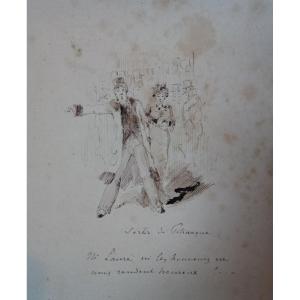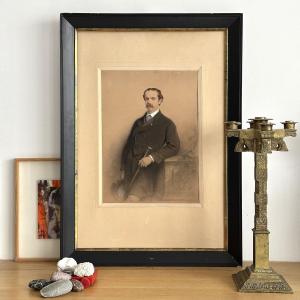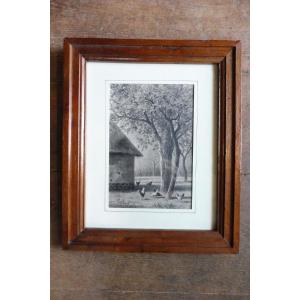Preparatory drawing for the Return from the Island of Elba February 1815
1866
Pencil,ink, brown lavish, white highlights
Signedbottom right « G. Cabasson »
18 x 13,5 cm (7 1/8 x 7 1/8 in.); Withframe : 30 x 24 cm (11 2/3 x 9 ½ in.)
Guillaume Cabasson, whose real name was Guillaume-Alphonse Harang, was born in Rouen on February 25, 1814. He joined the Académie des Beaux-Arts in Rouen, where he became a boarder, before going to Paris to complete his artistic studies. He studied under the sculptor Pierre-Jean David d'Angers, then became a student of Paul Delaroche, who introduced him to history painting. The latter made him his assistant and entrusted him with the restoration of the stained-glass windows of certain churches in Rouen, including that of Saint-Patrice, around 1840. That same year, he presented the painting The Captivity of Saint-Louis at the Exhibition of Norman Arts and Artists, for which he received a gold medal. He then exhibited at the Salon des artistes français from 1841 to 1882. In 1854, he apparently received a commission for a set depicting an Apotheosis of Napoleon III, of which only a sketch preserved at the Château de Compiègne has survived. In this work, Napoleon I appears at the top of the composition, in a cloud he blesses the reign of his nephew. Cabasson also produced several engravings illustrating the Napoleonic legend. From 1862, the Banque de France commissioned drawings from him to illustrate banknotes, notably the 50 franc bleu and the 500 franc bleu. In 1878, he became a professor at the École des Arts Décoratifs in Paris. The same year he was decorated with the Legion of Honor.
February 25, 1815, the return of the Eagle
After his abdication in 1814, Napoleon was exiled to the Island of Elba. After spending 300 days there, the deposed sovereign activated his networks and achieved a romantic escape that would contribute to his legend. In February 1815, the brig l'Inconstant was disguised as a British ship in order to recover the emperor and part of his army and disembark him in Cannes. Chroniclers describe the crossing: "Before leaving the island of Elba, Napoleon had written two proclamations, but when he wanted to have them written down, no one could decipher them. He threw them into the sea and dictated two others, one addressed to the army, the other to the French people. All those who knew how to write were engaged in making copies: drums, benches, and caps served as desks, and everyone cheerfully set to work. "It is this episode, perhaps one of the most powerful of the reign of Napoleon I, that Guillaume Cabasson chose to represent in his painting The Return from the Island of Elba, which he exhibited at the Salon of 1866. This work is now in a private collection. Our drawing is preparatory to this painting. It should also be compared to a sketch kept at the Marmottan Library. Both works allow us to study the artistic development of the artist, who preserved the original composition in the final work. Only the rope of the ship, which is on the right of the emperor in the preparatory work, appears behind the monarch in the painting.
Related artworks
- Guillaume-Alphonse CABASSON.1814-1884. Sketch for the Return from the Island of Elba: February 1815, 1866, Pencil, 18.5 x 14 cm, Marmottan Library, Boulogne-Billancourt, Inv. 1982-4
- Guillaume-Alphonse CABASSON.1814-1884. Return from the Island of Elba: February 1815, Salon of French Artists 1866, Oil on canvas, 70 x 55 cm, Private collection
Précis analytique des travaux de l'Académie dessciences, belles-lettres et arts de Rouen, Académie des sciences,belles-lettres et arts, 1840, Rouen
Gallois, Léonard-Charles-André-Gustave, Histoire deNapoléon, d'après lui-même, C. Béchet, 1825, Paris



























 Le Magazine de PROANTIC
Le Magazine de PROANTIC TRÉSORS Magazine
TRÉSORS Magazine Rivista Artiquariato
Rivista Artiquariato